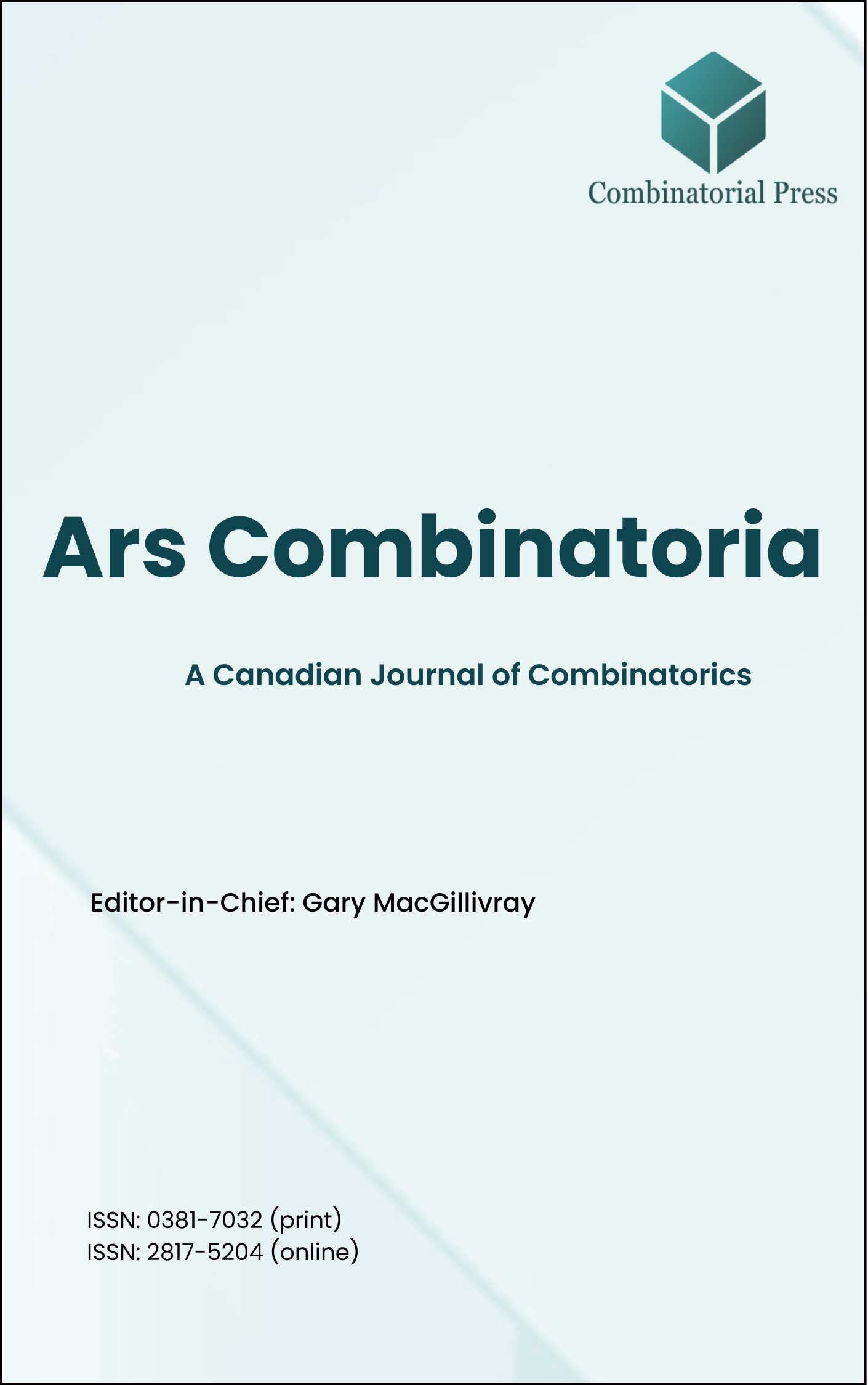
Ars Combinatoria
ISSN 0381-7032 (print), 2817-5204 (online)
Ars Combinatoria is the oldest Canadian Journal of Combinatorics, established in 1976. The journal is dedicated to advancing the field of combinatorial mathematics through the publication of high-quality research papers. From 2024 onward, it publishes four volumes per year in March, June, September and December. Ars Combinatoria has gained recognition and visibility in the academic community and is indexed in renowned databases such as MathSciNet, Zentralblatt, and Scopus. The Scope of the journal includes Graph theory, Design theory, Extremal combinatorics, Enumeration, Algebraic combinatorics, Combinatorial optimization, Ramsey theory, Automorphism groups, Coding theory, Finite geometries, Chemical graph theory but not limited.
Information Menu
- Research article
- Full Text
- Ars Combinatoria
- Volume 040
- Pages: 59-64
- Published: 31/08/1995
The paper \([2]\) claimed that a disconnected graph with at least two nonisomorphic components is determined by some three of its vertex deleted subgraphs. While this statement is true, the proof in \([2]\) is incorrect. We give a correct proof of this fact.
- Research article
- Full Text
- Ars Combinatoria
- Volume 040
- Pages: 49-58
- Published: 31/08/1995
It is shown that the necessary conditions for the existence of a \(k\)-cycle system of order \(n\) are sufficient for \(k \in \{20, 24, 28, 30, 33, 35, 36, 39, 40, 42, 44, 45, 48\}\), thus settling the problem for all \(k \leq 50\).
- Research article
- Full Text
- Ars Combinatoria
- Volume 040
- Pages: 3-48
- Published: 31/08/1995
In this paper we study competition graphs of digraphs of restricted degree.
We introduce the notion of restricted competition numbers of graphs.
We complete the characterization of competition graphs of indegree at most 2 and their restricted competition numbers.
We characterize interval \((2,3)\)-graphs and give a recognition algorithm for interval \((2,3)\)-digraphs.
We characterize competition graphs and interval competition graphs of digraphs of outdegree at most \(2\).
The relationship between restricted competition numbers and ordinary competition numbers are studied for several classes of graphs.
- Research article
- Full Text
- Ars Combinatoria
- Volume 039
- Pages: 281-285
- Published: 30/04/1995
A binary linear code of length \(n\), dimension \(k\), and minimum distance at least \(d\) is called an \([n,k,d]\)-code. Let \(d(n,k) = \max \{d : \text{there exists an } [n,k,d]\text{-code}\}\). It is currently known by [6] that \(26 \leq d(66,13) \leq 28\). The nonexistence of a linear \([66,13,28]\)-code is proven.
- Research article
- Full Text
- Ars Combinatoria
- Volume 039
- Pages: 276-280
- Published: 30/04/1995
In this paper, we completely solve the existence problem of \(\text{LOTS}(v)\) (i.e. large set of pairwise disjoint ordered triple systems of order \(v\)).
- Research article
- Full Text
- Ars Combinatoria
- Volume 039
- Pages: 261-275
- Published: 30/04/1995
It is shown that a resolvable BIBD with block size five and index two exists whenever \(v \equiv 5 \pmod{10}\) and \(v \geq 50722395\). This result is based on an updated result on the existence of a BIBD with block size six and index unity, which leaves \(88\) unsolved cases. A construction using difference families to obtain resolvable BIBDs is also presented.
- Research article
- Full Text
- Ars Combinatoria
- Volume 039
- Pages: 255-260
- Published: 30/04/1995
Functions \(c(n)\) and \(h(n)\) which count certain consecutive-integer partitions of a positive integer \(n\) are evaluated, and combinatorial interpretations of partitions with “\(c(n)\) copies of \(n\)” and “\(h(n)\) copies of \(n\)” are given.
- Research article
- Full Text
- Ars Combinatoria
- Volume 039
- Pages: 249-254
- Published: 30/04/1995
J. Leech has posed the following problem: For each integer \(n\), what is the greatest integer \(N\) such that there exists a labelled tree with \(n\) nodes in which the distance between the pairs of nodes include the consecutive values \(1,2,\ldots,N\)? With the help of a computer, we get \(B(n)\) (the number \(N\) for branched trees) for \(2 \leq n \leq 10\) and lower bounds of \(B(11)\) and \(B(12)\). We also get \(U(n)\) (the number \(N\) for unbranched trees) for \(2 \leq n \leq 11\) independently, confirming some results gotten by J. Leech.
- Research article
- Full Text
- Ars Combinatoria
- Volume 039
- Pages: 240-248
- Published: 30/04/1995
A method is presented for constructing simple partially balanced designs from \(t-(v,k,\lambda)\) designs. When the component designs satisfy a compatibility condition the result is a simple balanced design. The component designs can even be trivial (with some exceptions) with the resulting design being nontrivial. The automorphism group of the composition is given in terms of the automorphism groups of the component designs. Some previously unknown simple designs are constructed, including an infinite family of \(3\)-designs that are extremal with respect to an inequality of Cameron and Praeger. Some analogous theorems are given for difference families.
- Research article
- Full Text
- Ars Combinatoria
- Volume 039
- Pages: 231-239
- Published: 30/04/1995
In this paper, constructions of simple cyclic \(2\)-designs are given. As a consequence, we determined the existence of simple \(2\)-\((q,k,\lambda)\) designs for every admissible parameter set \((q,k,\lambda)\) where \(q \leq 29\) is an odd prime power, with two undecided parameter sets \((q,k,\lambda) = (29,8,6)\) and \((29,8,10)\).





